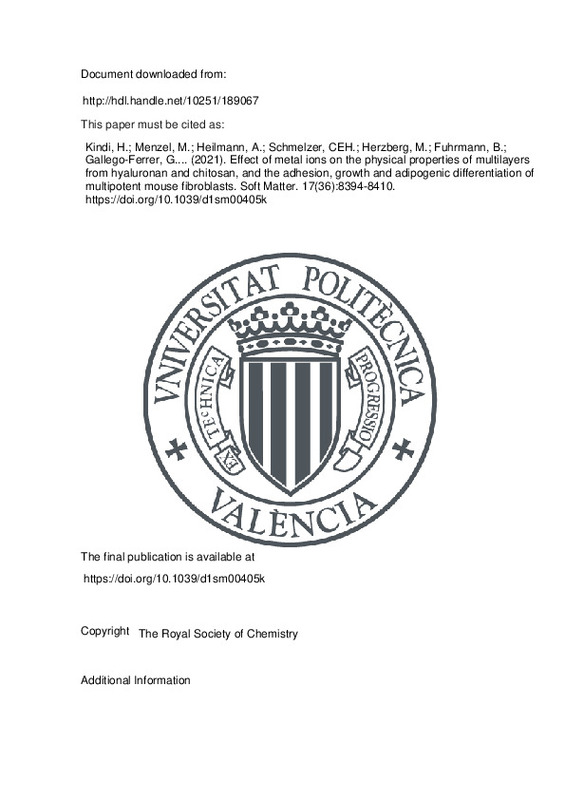JavaScript is disabled for your browser. Some features of this site may not work without it.
Buscar en RiuNet
Listar
Mi cuenta
Estadísticas
Ayuda RiuNet
Admin. UPV
Effect of metal ions on the physical properties of multilayers from hyaluronan and chitosan, and the adhesion, growth and adipogenic differentiation of multipotent mouse fibroblasts
Mostrar el registro sencillo del ítem
Ficheros en el ítem
| dc.contributor.author | Kindi, Husnia
|
es_ES |
| dc.contributor.author | Menzel, Matthias
|
es_ES |
| dc.contributor.author | Heilmann, Andreas
|
es_ES |
| dc.contributor.author | Schmelzer, Christian E. H.
|
es_ES |
| dc.contributor.author | Herzberg, Martin
|
es_ES |
| dc.contributor.author | Fuhrmann, Bodo
|
es_ES |
| dc.contributor.author | Gallego-Ferrer, Gloria
|
es_ES |
| dc.contributor.author | Groth, Thomas
|
es_ES |
| dc.date.accessioned | 2022-11-03T10:37:58Z | |
| dc.date.available | 2022-11-03T10:37:58Z | |
| dc.date.issued | 2021-09-28 | es_ES |
| dc.identifier.issn | 1744-683X | es_ES |
| dc.identifier.uri | http://hdl.handle.net/10251/189067 | |
| dc.description.abstract | [EN] Polyelectrolyte multilayers (PEMs) consisting of the polysaccharides hyaluronic acid (HA) as the polyanion and chitosan (Chi) as the polycation were prepared with layer-by-layer technique (LbL). The [Chi/HA](5) multilayers were exposed to solutions of metal ions (Ca2+, Co2+, Cu2+ and Fe3+). Binding of metal ions to [Chi/HA](5) multilayers by the formation of complexes with functional groups of polysaccharides modulates their physical properties and the bioactivity of PEMs with regard to the adhesion and function of multipotent murine C3H10T1/2 embryonic fibroblasts. Characterization of multilayer formation and surface properties using different analytical methods demonstrates changes in the wetting, surface potential and mechanical properties of multilayers depending on the concentration and type of metal ion. Most interestingly, it is observed that Fe3+ metal ions greatly promote adhesion and spreading of C3H10T1/2 cells on the low adhesive [Chi/HA](5) PEM system. The application of intermediate concentrations of Cu2+, Ca2+ and Co2+ as well as low concentrations of Fe3+ to PEMs also results in increased cell spreading. Moreover, it can be shown that complex formation of PEMs with Cu2+ and Fe3+ ions leads to increased metabolic activity in cells after 24 h and induces cell differentiation towards adipocytes in the absence of any additional adipogenic media supplements. Overall, complex formation of [Chi/HA](5) PEM with metal ions like Cu2+ and Fe3+ represents an interesting and cheap alternative to the use of growth factors for making cell-adhesive coatings and guiding stem cell differentiation on implants and scaffolds to regenerate connective-type of tissues. | es_ES |
| dc.description.sponsorship | This work was part of the High-Performance Center Chemical and Biosystems Technology Halle/Leipzig, supported by the European Regional Development Fund (ERDF), and a grant to HK from the Martin Luther University Halle-Wittenberg for female PhD students. The work was further supported by the Fraunhofer Internal Programs under Grant No. Attract 069-608203 (CEHS). TG acknowledges the kind support by the Ministry of Science and Higher Education of the Russian Federation within the framework of state support for the creation and development of World-Class Research Centers ``Digital biodesign and personalized healthcare'' 075-15-2020926. GGF acknowledges funding by the State Research Agency. Ministry of Science and Innovation of Spain, grant PID2019106000RB-C21/AEI/10.13039/501100011033 project. We are grateful for the kind support by Christian Willems for the help in formatting and proof reading the manuscript. | es_ES |
| dc.language | Inglés | es_ES |
| dc.publisher | The Royal Society of Chemistry | es_ES |
| dc.relation.ispartof | Soft Matter | es_ES |
| dc.rights | Reserva de todos los derechos | es_ES |
| dc.subject.classification | MAQUINAS Y MOTORES TERMICOS | es_ES |
| dc.title | Effect of metal ions on the physical properties of multilayers from hyaluronan and chitosan, and the adhesion, growth and adipogenic differentiation of multipotent mouse fibroblasts | es_ES |
| dc.type | Artículo | es_ES |
| dc.identifier.doi | 10.1039/d1sm00405k | es_ES |
| dc.relation.projectID | info:eu-repo/grantAgreement/AEI/Plan Estatal de Investigación Científica y Técnica y de Innovación 2017-2020/PID2019-106000RB-C21/ES/HIDROGELES BIOMIMETICOS IMPRIMIBLES CON PRESENTACION DE FACTORES DE CRECIMIENTO EFICIENTE PARA ESTUDIOS DE HEPATOTOXICIDAD DE ALTO RENDIMIENTO/ | es_ES |
| dc.relation.projectID | info:eu-repo/grantAgreement/Ministry of Science and Higher Education of the Russian Federation//075-15-2020926/ | es_ES |
| dc.rights.accessRights | Abierto | es_ES |
| dc.contributor.affiliation | Universitat Politècnica de València. Escuela Técnica Superior de Ingenieros Industriales - Escola Tècnica Superior d'Enginyers Industrials | es_ES |
| dc.contributor.affiliation | Universitat Politècnica de València. Centro de Biomateriales e Ingeniería Tisular - Centre de Biomaterials i Enginyeria Tissular | es_ES |
| dc.contributor.affiliation | Universitat Politècnica de València. Departamento de Termodinámica Aplicada - Departament de Termodinàmica Aplicada | es_ES |
| dc.description.bibliographicCitation | Kindi, H.; Menzel, M.; Heilmann, A.; Schmelzer, CEH.; Herzberg, M.; Fuhrmann, B.; Gallego-Ferrer, G.... (2021). Effect of metal ions on the physical properties of multilayers from hyaluronan and chitosan, and the adhesion, growth and adipogenic differentiation of multipotent mouse fibroblasts. Soft Matter. 17(36):8394-8410. https://doi.org/10.1039/d1sm00405k | es_ES |
| dc.description.accrualMethod | S | es_ES |
| dc.relation.publisherversion | https://doi.org/10.1039/d1sm00405k | es_ES |
| dc.description.upvformatpinicio | 8394 | es_ES |
| dc.description.upvformatpfin | 8410 | es_ES |
| dc.type.version | info:eu-repo/semantics/publishedVersion | es_ES |
| dc.description.volume | 17 | es_ES |
| dc.description.issue | 36 | es_ES |
| dc.identifier.pmid | 34550141 | es_ES |
| dc.relation.pasarela | S\459118 | es_ES |
| dc.contributor.funder | AGENCIA ESTATAL DE INVESTIGACION | es_ES |
| dc.contributor.funder | European Regional Development Fund | es_ES |
| dc.contributor.funder | Ministry of Science and Higher Education of the Russian Federation | es_ES |







![[Cerrado]](/themes/UPV/images/candado.png)

